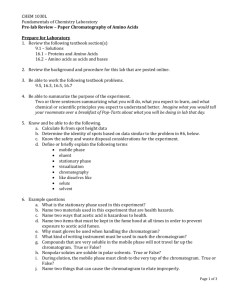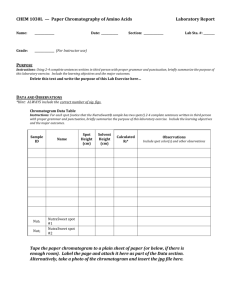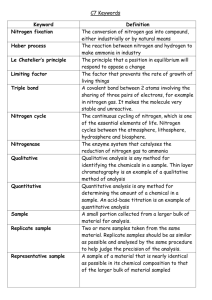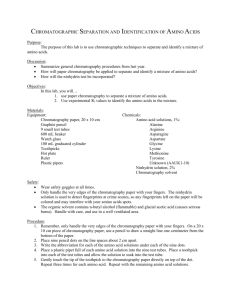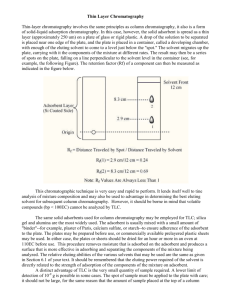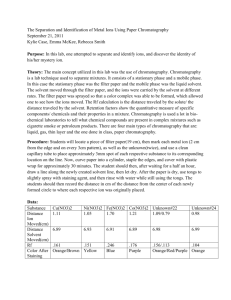Amino Acid Procedures
advertisement
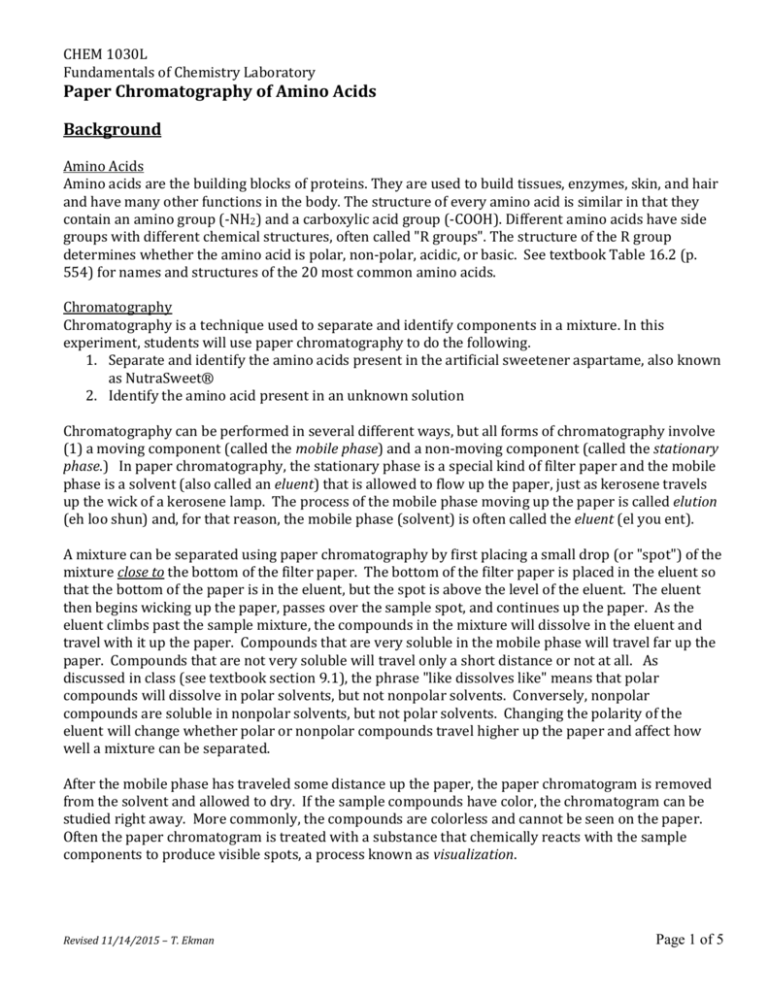
CHEM 1030L Fundamentals of Chemistry Laboratory Paper Chromatography of Amino Acids Background Amino Acids Amino acids are the building blocks of proteins. They are used to build tissues, enzymes, skin, and hair and have many other functions in the body. The structure of every amino acid is similar in that they contain an amino group (-NH2) and a carboxylic acid group (-COOH). Different amino acids have side groups with different chemical structures, often called "R groups". The structure of the R group determines whether the amino acid is polar, non-polar, acidic, or basic. See textbook Table 16.2 (p. 554) for names and structures of the 20 most common amino acids. Chromatography Chromatography is a technique used to separate and identify components in a mixture. In this experiment, students will use paper chromatography to do the following. 1. Separate and identify the amino acids present in the artificial sweetener aspartame, also known as NutraSweet® 2. Identify the amino acid present in an unknown solution Chromatography can be performed in several different ways, but all forms of chromatography involve (1) a moving component (called the mobile phase) and a non-moving component (called the stationary phase.) In paper chromatography, the stationary phase is a special kind of filter paper and the mobile phase is a solvent (also called an eluent) that is allowed to flow up the paper, just as kerosene travels up the wick of a kerosene lamp. The process of the mobile phase moving up the paper is called elution (eh loo shun) and, for that reason, the mobile phase (solvent) is often called the eluent (el you ent). A mixture can be separated using paper chromatography by first placing a small drop (or "spot") of the mixture close to the bottom of the filter paper. The bottom of the filter paper is placed in the eluent so that the bottom of the paper is in the eluent, but the spot is above the level of the eluent. The eluent then begins wicking up the paper, passes over the sample spot, and continues up the paper. As the eluent climbs past the sample mixture, the compounds in the mixture will dissolve in the eluent and travel with it up the paper. Compounds that are very soluble in the mobile phase will travel far up the paper. Compounds that are not very soluble will travel only a short distance or not at all. As discussed in class (see textbook section 9.1), the phrase "like dissolves like" means that polar compounds will dissolve in polar solvents, but not nonpolar solvents. Conversely, nonpolar compounds are soluble in nonpolar solvents, but not polar solvents. Changing the polarity of the eluent will change whether polar or nonpolar compounds travel higher up the paper and affect how well a mixture can be separated. After the mobile phase has traveled some distance up the paper, the paper chromatogram is removed from the solvent and allowed to dry. If the sample compounds have color, the chromatogram can be studied right away. More commonly, the compounds are colorless and cannot be seen on the paper. Often the paper chromatogram is treated with a substance that chemically reacts with the sample components to produce visible spots, a process known as visualization. Revised 11/14/2015 – T. Ekman Page 1 of 5 Retention Factor (Rf) The Rf value (short for "retention factor") is a measure of how far a compound travels up the paper compared to the distance traveled by the solvent. It is calculated from the chromatogram. Sample components can be identified by comparing each of their Rf values to the Rf values of known reference compounds. Rf = distance traveled by the sample spot distance traveled by the solvent Because no spot can travel further than the solvent front, the Rf cannot have a value greater than 1.0. In fact, an Rf of 1.0 indicates that the sample was completely soluble in the mobile phase, which is a rare occurrence. An Rf will be calculated for each spot on the chromatogram. Two measurements are required for each Rf value. First, measure the distance from the starting line to the center (or densest part) of each spot, to the nearest 0.1 cm (one decimal place). To determine the distance traveled by the solvent, measure the distance (to the nearest 0.1 cm) from the starting line, through the sample spot, to the solvent front line. Any sample that produces more than one spot (such as NutraSweet) will have more than one Rf value – one for each spot. In the example at the right, the solvent front traveled 8.0 cm at every point across the entire chromatogram. Reference compound A traveled 4.0 cm and the Rf was calculated to be 0.50. Reference compound B traveled 5.0 cm and Rf = 0.63. The unknown sample C was separated into two spots (C1 and C2), which indicated that C was a mixture of two compounds. One of the sample compounds (C1) traveled 4.0 cm and Rf = 0.50. The other compound in the unknown sample (C2) traveled 5.0 cm and Rf = 0.63. The Rf values of the sample spots were compared to the Rf values of the known reference compounds. It was found that C1 had the same Rf value as reference compound A and sample spot C2 had the same Rf as reference compound B. It was concluded that sample C was a mixture of compounds A and B. Revised 11/14/2015 – T. Ekman Page 2 of 5 Procedure Preparation of Elution Chamber 1. Write your name on a piece of labeling tape and attach it to a clean, dry 400-mL beaker. 2. Cover the top of the beaker with a piece of plastic wrap, which is available on the back bench. 3. Take the covered beaker and a rubber band to the fume hood. 4. Place 15 mL of solvent in the beaker. 5. Cover the beaker with the plastic wrap and secure it with the rubber band. 6. Leave the beaker in the fume hood. SAFETY The eluent includes acetic acid (the acid in vinegar) is a health hazard for two reasons. It can cause skin irritation. Avoid skin contact by using gloves. Wash any affected skin with soap and water. Acetic acid fumes can cause respiratory problems for sensitive individuals. To minimize exposure to fumes, (1) all elution chambers MUST be kept in the fume hood at all times and (2) the paper chromatograms MUST be dry and approved by the instructor before they are removed from the fume hood. Preparation of Chromatogram 1. Prepare the workstation by putting on a pair of gloves and unfolding and spreading out two sheets of paper towel on the bench top. 2. With gloved hands, obtain a sheet of Whatman No. 1 chromatography paper from the instructor. 3. Return to the workstation and place the chromatography paper on top of the paper towel. Technique: Body oil left behind by human fingerprints contains amino acids. The paper chromatogram must not be touched by bare hands or come into contact with other surfaces contaminated with fingerprints. Contaminating fingerprints will appear when the sample spots are visualized at the end of the experiment and may make the interpretation of the chromatogram difficult or impossible. It is important to use gloves when handling the paper chromatogram! 4. Use a ruler and pencil (not a pen!) To draw a straight line 2 cm above the long edge of the filter paper. 5. To mark the positions where the sample spots will be applied to the paper, make 8 small vertical marks across the horizontal pencil line that are spaced about 2 cm apart across the paper. 6. At the top of the chromatogram, write the three-letter abbreviation for each of the amino acids, the NutraSweet, and the unknown sample ID, in the order stated by the following list. Lys, for lysine Asp, for aspartic acid Glu, for glutamic acid Unknown sample ID (record it from the sample bottle) Nut, for NutraSweet Ala, for alanine Revised 11/14/2015 – T. Ekman Page 3 of 5 Pro, for proline Ala, for alanine 7. Use a pencil to make two small tick marks at the left or right edge of the paper that are 2 cm and 3 cm from the top of the paper. 8. Following the instructor demonstration, use a capillary tube to place a single, small spot of each sample on the chromatogram. Elution of the Chromatogram 1. Roll the paper into a cylinder and staple the edges together, according to the instructor demonstration. IMPORTANT: Do not allow the edges to overlap. If the edges overlap, the chromatogram may elute improperly. 2. Stand the cylinder next to the beaker and check to see that the sample spots are higher than the level of the solvent in the beaker. If the solvent level is higher than the level of the spots, use a disposable pipet to remove some of the solvent from the beaker until the level is lower than that of the spots. 3. Remove the plastic wrap "lid" and carefully lower the paper cylinder into the elution chamber (beaker), with the spotted edge down. Do not allow the paper to touch the sides of the beaker, which will cause the chromatogram to elute improperly. 4. Cover the beaker with the plastic wrap and leave it undisturbed in the fume hood. 5. Check the level of the solvent front every 10-15 minutes until it is between the 2-cm and 3-cm tick marks previously placed near the top edge of the paper. Do not allow the solvent front to reach the top of the paper, which can result in incorrect Rf values. 6. Once the solvent front has climbed to within 2-3 cm of the top of the paper, remove the paper from the elution chamber, but keep it in the fume hood! Remove the staples and spread the filter paper flat on a piece of clean paper towel. Immediately, use a pencil to trace the solvent front across the entire chromatogram. Note that the solvent front height can vary across the chromatogram, especially if the edges overlapped or the cylinder touched the inside of the beaker. 7. Pour the used mobile phase in the designated waste container in the fume hood. Visualization of the Chromatogram 1. Move the damp chromatogram to the drying area and allow it to dry completely, as demonstrated by the instructor. Technique: The chromatogram will feel cool to the touch if it is still damp. 2. Inform the instructor when the chromatogram is completely dry. The instructor will spray the chromatogram with the visualization agent, called ninhydrin. SAFETY Ninhydrin is a health hazard and should be handled only by the instructor. 3. Follow the instructor instructions to dry the chromatogram again, until the chromatogram is no longer cool to the touch. The amino acid spots may begin to appear during the drying process. 4. After the instructor has confirmed that the chromatogram appears to be completely dry, place the chromatogram in a drying oven or otherwise follow the instructor's directions to complete the visualization process. Waste Disposal When the Revised 11/14/2015 – T. Ekman Page 4 of 5 Data Collection Because the amino acid spots will fade over time, it is important to record their exact locations for future study. 1. Use a pencil to draw a line around the outside of each spot. 2. Draw a horizontal line through the densest part of each spot or through the center of the spot if the color density is the same through out the spot. Ask the instructor for help, if necessary. 3. Use a ruler to measure the distance above the starting line for the first spot. Record the distance to the nearest 0.1 cm (one decimal place). Without moving the ruler, measure the distance through the spot up to the solvent front and record the distance to the nearest 0.1 cm. 4. Record the color of each spot in the Observations section of the lab report. Note that NutraSweet will have two spots. Identification of the Sample Components In the lab report, use the Rf values and spot colors to identify each spot in the NutraSweet and the unknown sample. One strategy to do this is to use color and Rf values to eliminate amino acids that are not good matches until the best match remains. Ask the instructor for guidance, if you are unsure how to identify the spots. Revised 11/14/2015 – T. Ekman Page 5 of 5
